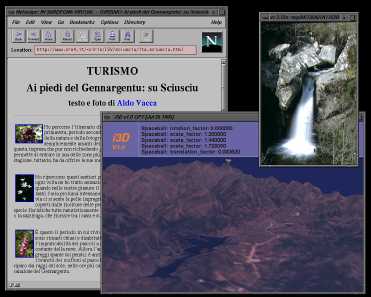1. Introduction
The World-wide Web (WWW) has rapidly become one of the fundamental
structures of the Internet. By imposing a universal organization on
the variety of formats in which data resides around the world, and
allowing each piece to be viewed as a uniquely addressable data
source, it has allowed the entire Internet to be treated as a single
structured document [2]. This enormous
distributed database, which can be universally accessed using a single
software application known as a web browser, takes the form of a
hyper-media document, combining text, images, sound and video into a
seamless, hyperlinked user-interface. Recently, with the advent of
graphics workstations able to display scenes composed of hundreds of
thousands of polygons at interactive speeds, it has become possible to
consider including 3D scenes as one of the types of documents that can
be hyperlinked in this information universe. VRML browsers, that offer
interactive viewing of 3D scenes and hyperlink selection capabilities
are starting to be developed for integrating 3D graphics with the WWW
[5]. The relatively low-cost of modern
3D graphics workstations makes it possible for a large community to
benefit from this evolution.
The Virtual Sardinia project builds on these recent advances. Its
goal is to collect a large amount of heterogeneous data concerning the
island of Sardinia and representing them in such a way that a casual
user can easily navigate through these data in a virtual trip. The
front end for accessing these data is a detailed 3D reconstruction of
the island of Sardinia that can be explored in real-time. All the
related data are interconnected in an hypermedia way, browsable in the
WWW, ranging from geographic to archaeological data, from historical
to touristical info, both in 2D and 3D. Thanks to this project,
Sardinia becomes a wonderful place to visit also in the intangible Web
information universe.

Figure 1. Sight-seeing in Virtual Sardinia
In this paper we provide an overview of the Virtual Sardinia
project. All the features described here can be accessed at the
address http://www.crs4.it/PRJ/VIRTSARD/.
�
